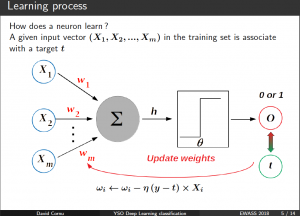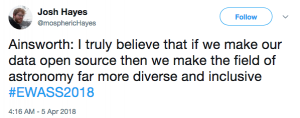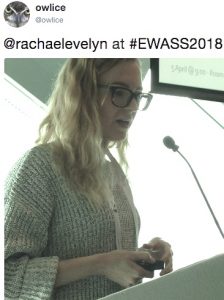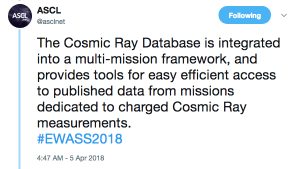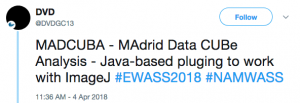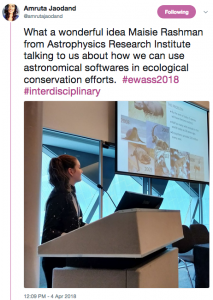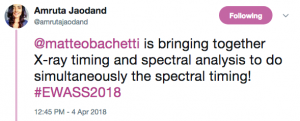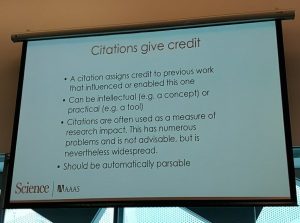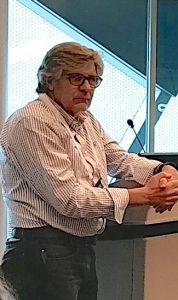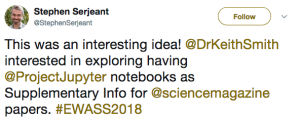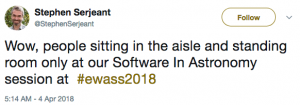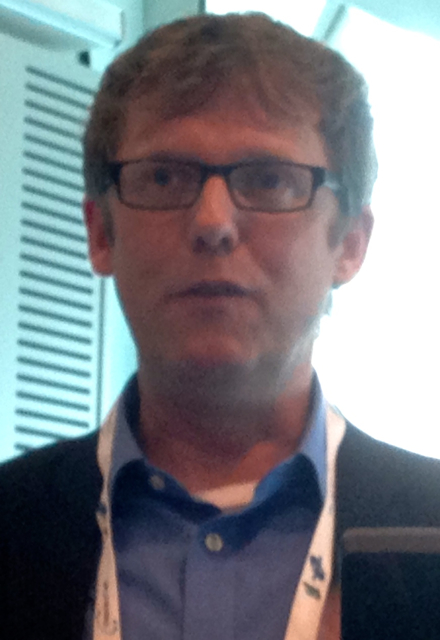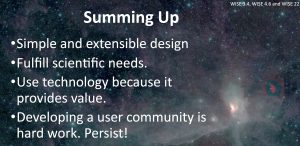It’s that time of year again when software folks — users and authors alike — dream of all the software activities at the winter AAS meeting. So here is the ASCL’s (abbreviated*) annual round-up to jumpstart your dreams and warm your code-loving heart! If you have items you want added, please let me know in the comments below or send an email to editor@ascl.net. Thank you!
All rooms are in the Washington State Convention Center unless otherwise specified.
SATURDAY, 5 JANUARY 2019
Workshops
Introduction to Software Carpentry (Day 1), 9:00 AM – 5:00 PM; 211
The AAS Chandra/CIAO Workshop, 9:00 AM – 6:00 PM; 204
Using Python to Search NASA’s Astrophysics Archives, 10:00 AM – 11:30 AM; 213
SUNDAY, 6 JANUARY 2019
Workshops
SOFIA Workshop for FORCAST and HAWC+ Data Analysis, 8:30 AM – 5:15 PM; 201
Adding LISA to your Astronomy Tool Box, 9:00 AM – 5:00 PM; 213
Introduction to Software Carpentry (Day 2), 9:00 AM – 5:00 PM; 211
Using Python and Astropy for Astronomical Data Analysis, 9:00 AM – 5:00 PM; 4C-4
The AAS Chandra/CIAO Workshop, 9:00 AM – 6:00 PM; 204
Advanced Searching in the New ADS: On the Web and Using the API, 3:00 PM – 4:30 PM; 304
MONDAY, 7 JANUARY 2019
Splinter meetings
Data Science, 8:00 AM – 6:00 PM, 4C-1
Updates on Implementing Software Citation in Astronomy, 12:30 PM – 2:00 PM; 203
An Open Discussion on Astronomy Software, 2:00 PM – 3:30 PM; 4C-4
Open event
AAS WorldWide Telescope presents: Advances in Astronomical Visualization, 10:00 AM – 11:30 AM; 214
Oral presentations
Session 126. Machine Learning in Astronomical Data Analysis, 2:00 PM – 3:30 PM; 607 (5 presentations)
Also:
112.01. Constraining BH formation with 2M05215658+4359220, 10:00 AM – 10:10 AM, 612
109.03. Real-time data reduction pipeline and image analysis software for FIREBall-2: first flight with a δ-doped UV-EMCCDs operating in counting mode, 10:30 AM – 10:40 AM, 608
175.06. Python, Unix, Observing, and LaTeX: Introducing First Year Undergraduates to Astronomical Research, 10:50 AM – 11:00 AM, 620
109.08. TESS Data Analysis using the community-developed Lightkurve Python Package, 11:20 AM – 11:30 AM, 608
123.02D. A Uniform Analysis of Exoplanet Atmosphere Spectra Observed by HST WFC3 Is Consistent with Watery Worlds, 2:10 PM – 2:30 PM, 6C
129.06. Reconstructing the Orphan Stream Progenitor with MilkyWay@home Volunteer Computing, 3:00 PM – 3:10 PM, 611
Selected posters
144.25. Identifying and Comparing Centrally Star-Forming Galaxies Using MaNGA
144.29. Deriving star formation histories from photometric spectral energy distributions with diffusion k-means
144.30. Using Convolutional Neural Networks to predict Galaxy Metallicity from Three-Color Images
144.35. Automatic Detection and Analysis of Debris from Galactic Accretion Events
145.05. Galaxy Gradients Across Simulations
145.07. Reduction and Analysis of GMOS Spectroscopy for Herschel Sources in CANDELS
145.25. Comparison of the HI Signal Extraction Algorithms of SoFiA and ALFALFA
140.02. Tracking the TESS Pipeline
140.12. Undergraduates Can Find Planets Too
140.16. Identifying Transiting Exoplanets in with Deep Learning in K2 Data
140.20. The Impact of Small Statistics on Identifying Background False Positives in Kepler Data
140.23. AutoRegressive Planet Search for Ground-Based Transit Surveys
140.29. Getting to Know Your Star: A comparison of analytic techniques for deriving stellar parameters and abundances
149.18. NANOGrav: Data Accessibility, Analysis and Automation using Python
150.01. Revised Simulations of the Planetary Nebulae Luminosity Function
150.15. Identifying Binary Central Stars of Planetary Nebulae with PSF Fitting
158.02. HaloSat: X-Ray Calibration and Spectral Analysis for a NASA CubeSat
162.04. The Starchive
Selected iPosters
167.02. Modeling circumstellar dust around low-mass-loss rate carbon-rich AGB stars
167.04. The response of optical Fe II emission in AGNs to changes in the ionizing continuum, I: photoionization modelling
164.02. A Maximum Likelihood Approach to Extracting Photon-Starved Spectra of Directly Imaged Exoplanets
166.02. Smoothed Particle Inference Analysis of SNR DEM L71
171.03. The State of Software Tools for the Space Telescope Imaging Spectrograph
Other activities of possible interest
Monday, January 7: Data Science Splinter Meeting, 8:00 AM – 6:00 PM, 4C-1
TUESDAY, 8 JANUARY 2019
Workshop
LSST Science Pipelines Stack Tutorial for AAS, 9:00 AM – 5:00 PM; 310
Splinter meeting
Cafe SCiMMA: Conceptualizing an NSF Center for Scalable Cyberinfrastructure for Multimessenger Astrophysics, 3:15 PM – 5:15 PM; Redwood (Sheraton Seattle Hotel)
Oral presentations
Session 225. Computation, Data Science, and Image Analysis, 2:00 PM – 3:30 PM, 6E (6 presentations)
Also:
218.05. A Uniform Analysis of Kepler/K2 Exoplanet Transit Parameters, 10:40 AM – 10:50 AM, 603
206.05D. High Resolution spatial analysis of z ~2 lensed galaxy using pixelated source-reconstruction algorithm, 10:50 AM – 11:10 AM, 605/610
203.05. Atmosphere Retrieval of Planetary Mass Companions with the APOLLO Code: A Case Study of HD 106906b and Prospects for JWST, 11:00 AM – 11:10 AM, 6B
207.10. astroquery: An Astronomical Web-Querying Package in Python, 11:03 AM – 11:10 AM, 606
239.04D. Kinematics of Circumgalactic Gas and Cold Gas Accretion at Redshift z=0.2, 2:40 PM – 3:00 PM, 609
227.07. Mu and You: Public Microlensing Analysis Tools and Survey Data, 3:12 PM – 3:24 PM, 606
Poster presentations
Session 245. Computation, Data Science, and Image Analysis posters (31 posters!)
Selected posters
243.08. Utilizing Independent Component Analysis to Explore the Diversity of Quasars
245.01. Making organizational research software more discoverable
245.27. The MAESTROeX low Mach number stellar hydrodynamics code
245.29. The Castro Adaptive Mesh Refinement Hydrodynamics Code: Applications, Algorithm Development, and Performance Portability
247.30. Chemical Analysis of Tabby’s Star (KIC 8462852)
247.35. VPLanet: The VIrtual Planet Simulator
249.11. Know Your Neighbors: New Catalogs and Analysis of Star Clusters in the LMC, SMC, & M33
250.02. X-Ray Source Analysis In The Globular Clusters NGC 6341 and NGC 6541
253.06. Structure Function Analysis of Turbulent Properties in the Small and Large Magellanic Clouds
259.05. Forward-Modeling Analysis of Late-T Dwarf Atmospheres
259.15. Finding age relations for low mass stars using magnetic activity and kinematics
259.24. A Uniform Retrieval Analysis on a Sample of 16 T-dwarfs
258.25. SuperNovae Analysis aPplication (SNAP): Identifing and Understanding the Physics of Supernovae
Selected iPosters
268.02. Towards 3D Parameter Space Studies of CCSNe With Grey, Two-Moment Neutrino Transport
261.12. Using Machine Learning to Predict the Masses of Galaxy Clusters
261.15. Mapping Galaxy Cluster Orientations from Cosmo-OWLS Simulations
261.16. A Hydrodynamical Simulation of the Off-Axis Cluster Merger Abell 115
WEDNESDAY, 9 JANUARY 2019
Open meeting
AAS WorldWide Telescope with Python and Astropy, 10:00 AM – 11:30 AM; 214
Oral presentations
316.04D. Feedback and Chemical Enrichment in Low Mass Dwarf Galaxies: Insights from Simulations Tracking Individual Stars, 10:30 AM – 10:50 AM, 617
304.03. Recent upgrades to the pyLIMA software for microlensing modeling and analysis of two binary events, 10:10 AM – 10:20 AM, 6E
311.05. Quantifying the effects of spatial resolution and noise on galaxy metallicity gradients, 11:00 AM – 11:10 AM, 612
313.05D. Probabilistic data analysis methods for large photometric surveys, 10:50 AM – 11:10 AM, 614
336.04D. Simultaneous modelling of X-rays emission and optical polarization of intermediate polars using the CYCLOPS code: the case of V405 Aurigae, 2:40 PM – 3:00 PM, 614
342.06. On Open Cluster Disruption, 3:00 PM – 3:10 PM, 620
341.01. Reproducing Stellar Rotation Periods in the Kepler Field via Magnetic Braking and Tidal Torques
Selected posters
346.04. Designing a Python Module for the Calculation of Molecular Parameters and Production Rates in Comets
347.01. Hyperlink preservation in astrophysics papers
348.19. The COBAIN code. Basic principles and geometrical considerations
348.27. Considerations and Design Principles for the 2.1 Release of the PHOEBE Eclipsing Binary Modeling Code
356.06. Analysis of a large number of spiral galaxies shows asymmetry between clockwise and counterclockwise galaxies
Session 381. Computation, Data Science, and Image Analysis session (8 iPosters)
Selected iPosters
381.03. ASTROstream: Automated claSsification of Transient astRonomical phenOmena in the streaming mode
381.05. Understanding and using the Fermitools
381.07. Polarization Calibration Post-Pipeline in CASA: Pilot Implementation
381.08. Transitioning from ADS Classic to the new ADS search platform
THURSDAY, 10 JANUARY 2019
Hack Together Day
8:30 AM – 7:00 PM; 4C-2
Oral presentations
413.06. The Radio Astronomy Software Group: Foundational Tools for 21 cm Cosmology and Beyond, 11:10 AM – 11:20 AM, 614
408.07D. Hundreds of New Planet Candidates from K2, 11:00 AM – 11:20 AM, 608
411.05D. AzTEC Survey of the Central Molecular Zone: Modeling Dust SEDs and N-PDF with Hierarchical Bayesian Analysis, 10:40 AM – 11:00 AM, 612
405.05. How can new data analysis methods get more out of Kepler/K2 data?, 10:40 AM – 10:50 AM, 605/610
425.01. The Dedalus project: open source science in astrophysics with examples in convection and stellar dynamos, 2:00 PM – 2:22 PM, 606
430.02D. Analysis of the spatially-resolved V-3.6μm colors and dust extinction within 257 nearby NGC and IC galaxies, 2:20 PM – 2:40 PM, 612
Selected posters
443.11. WFC3 PSF Database and Analysis Tools
457.02. The Stak Notebooks: Transitioning From IRAF to Python
442.01. ExoPhotons: Exoplanet Monte Carlo Radiative Transfer
442.02. Quantifying inhomogeneities in the HI distributions of simulated galaxies
445.01. Lightkurve v1.0: Kepler, K2, and TESS time series analysis in Python
445.05. Using Kepler DR25 Products to Compute Exoplanet Ocurrence Rates
465.07. Distribution of stellar rotation periods using light curve analysis of second phase Kepler data
* abbreviated as in I haven’t listed all the posters that could be listed here, as the list was getting very very long…





